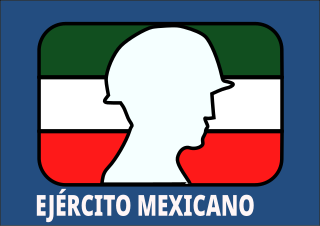Related Research Articles
A drug cartel is any criminal organization with the intention of supplying drug trafficking operations. They range from loosely managed agreements among various drug traffickers to formalized commercial enterprises. The term was applied when the largest trafficking organizations reached an agreement to coordinate the production and distribution. The term is used to refer to any criminal narcotics related organization.
A narcocorrido is a subgenre of the Regional Mexican corrido genre, from which several other genres have evolved. This type of music is heard and produced on both sides of the Mexico–US border. It uses a danceable, polka, waltz or mazurka rhythmic base.

Iguala, known officially as Iguala de la Independencia, is a historic city located 102 km (63 mi) from the state capital of Chilpancingo, in the Mexican state of Guerrero in southwestern Mexico.

Los Zetas is a Mexican criminal syndicate, regarded as one of the most dangerous of Mexico's drug cartels. They are known for engaging in brutally violent "shock and awe" tactics such as beheadings, torture, and indiscriminate murder. While primarily concerned with drug trafficking, the organization also runs profitable sex and gun rackets. Los Zetas also operate through protection rackets, assassinations, extortion, kidnappings and other illegal activities. The organization is based in Nuevo Laredo, Tamaulipas, directly across the border from Laredo, Texas. The origins of Los Zetas date back to the late 1990s, when commandos of the Mexican Army deserted their ranks and began working as the enforcement arm of the Gulf Cartel. In February 2010, Los Zetas broke away and formed their own criminal organization, rivalling the Gulf Cartel.

The Mexican Army is the combined land and air branch and is the largest part of the Mexican Armed Forces; it is also known as the National Defense Army.
The Mexican Secretariat of National Defense(SEDENA); Spanish: Secretaría de la Defensa Nacional is the government department responsible for managing Mexico's Army and Air Forces. Its head is the Secretary of National Defense who, like the co-equal Secretary of the Navy, is directly answerable to the President. Before 1937, the position was called the Secretary of War and Navy. The agency has its headquarters in Lomas de Sotelo, Miguel Hidalgo, Mexico City. Some key figures who answer directly to the Secretary are the Assistant Secretary, the Chief of Staff of the Armed Forces, and all military tribunals.
The Mexican drug war is the Mexican theater of the global war on drugs, as led by the U.S. federal government, an ongoing asymmetric low-intensity conflict between the Mexican government and various drug trafficking syndicates. When the Mexican military began to intervene in 2006, the government's main objective was to reduce drug-related violence. The Mexican government has asserted that their primary focus is dismantling the cartels, and preventing drug trafficking demand along with U.S. functionaries.

Mexploitation is a film genre of low-budget films that combine elements of an exploitation film and Mexican culture or portrayals of Mexican life within Mexico often dealing with crime, drug trafficking, money and sex.
The timeline of some of the most relevant events in the Mexican drug war is set out below. Although violence between drug cartels had been occurring for three decades, the Mexican government held a generally passive stance regarding cartel violence through the 1980s and early 2000s.
Canelas is a town and seat of the municipality of Canelas, in the state of Durango, northwestern Mexico. Canelas is also known for a wedding that took place, that of the famous Mexican drug lord Joaquín Guzmán Loera and Emma Coronel Aispuro. Reports indicate that this wedding took place in 2007 in Canelas. As of 2010, the town had a population of 734.
Teodoro García Simental is a former lieutenant of the Mexican criminal organization known as the Tijuana Cartel, and later allied with the Sinaloa Cartel. He was arrested by Mexican Federal Police - Special Forces on 12 January 2010 in La Paz, Baja California Sur.
Coordinated Operation Chihuahua or formerly known as Joint Operation Chihuahua is a Military and Federal Police operation started in 2008 by the Mexican Army and Policía Federal Preventiva. The objective is to "besiege" Ciudad Juárez to concentrate forces and saturate the area to confront the three cartels already operating in the city. Ciudad Juárez is known to be one of the most dangerous cities in the Americas. In the year 2007 more than 100 police officers were killed in Juárez in attacks blamed on organized crime. As a result of drug cartel violence, President Felipe Calderón has previously launched other Joint Operations in other states.
Manuel Fidel Torres Félix, also known as El M1 and/or El Ondeado, was a suspected Mexican drug lord and high-ranking leader of a cell within the Sinaloa Cartel.
The Milenio Cartel, or Cártel de los Valencia, was a Mexican criminal organization based in Michoacán. It relocated to Jalisco in the early 2000s. The Jalisco New Generation Cartel was born from the splintering of the Milenio Cartel.

Salvador Cienfuegos Zepeda is a retired Mexican Army officer. He served as the Secretary of National Defense in the government of President Enrique Peña Nieto from 2012 to 2018.
Javier Torres Félix is an imprisoned Mexican drug lord and former high-ranking leader of the Sinaloa Cartel, a drug trafficking organization. He is the brother of the deceased drug lord Manuel Torres Félix and the former right-hand man of Ismael "El Mayo" Zambada, a top cartel leader.
Zuyaqui was a Mexican dog who, according to SEDENA, was the dog who found the most drugs in Mexican military and police history.

Juan Arévalo Gardoqui served as Mexico's Secretary of Defense from 1982 to 1988.
Guacamaya is an international group of hackers that has published anonymous reports and leaked sensitive files in the public interest through Distributed Denial of Secrets and Enlace Hacktivista. It operates mainly in Central and Latin America and to date has hacked major corporations and the governments of Chile, Colombia, El Salvador, Guatemala, Mexico and Peru.
References
- ↑ "Narco Museo". Wn.com. Retrieved 2015-06-25.
- ↑ "El museo del narco – Marcianos". Marcianosmx.com. 25 January 2010. Retrieved 2015-06-25.
- ↑ "Ley de Transparencia". Sedena.gob.mx. Retrieved 2015-06-25.
- ↑ "Mexican museum details the real enemy: drug cartels". Washingtonpost.com. 2010-01-13. Archived from the original on 2011-02-12. Retrieved 2015-06-25.
- ↑ "Museo del Enervante, historia del narco". Elsiglodedurango.com.mx. 2008-10-21. Retrieved 2015-06-25.
- ↑ "El museo del narco mexicano | México". Elmundo.es. Retrieved 2015-06-25.
- ↑ "Museo del Enervante". Taringa.net. 2010-01-08. Retrieved 2015-06-25.